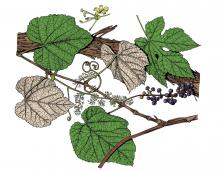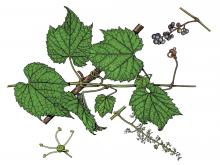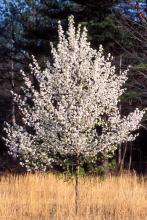Trees, Shrubs and Woody Vines
Media

Species Types
Scientific Name
Smilax hispida (syn. S. tamnoides var. hispida)
Description
Bristly greenbrier is a stout woody vine with bristlelike black spines, climbing high by tendrils to a length of 40 feet. It is the most common greenbrier in Missouri and is found statewide.
Media

Species Types
Scientific Name
Vitis aestivalis
Description
Summer grape is a vigorous, woody, wild grapevine climbing to a height of 35 feet. It grows mostly in the southern two-thirds of Missouri, often in drier situations than many other grape species.
Media

Species Types
Scientific Name
Vitis riparia
Description
Riverbank grape is a woody wild grape vine climbing to 75 feet by means of tendrils. It occurs nearly statewide but is absent from most of the Ozark plateau.
Media

Species Types
Scientific Name
Rosa multiflora
Description
Starting more than a century ago, this nonnative rose was planted across America — for many good reasons — but multiflora rose has proven to be invasive, and now the goal is to stop its spread.
Media

Species Types
Scientific Name
Rosa setigera
Description
Also called climbing rose, prairie rose is most common near woodlands, where it climbs and trails on neighboring shrubs and small trees.
Media

Species Types
Scientific Name
Various species in the genus Crataegus
Description
Our state flower, the hawthorn, is solidly represented in Missouri. There are about 100 different kinds of hawthorns that occupy almost every kind of soil in every part of the state. These members of the rose family are closely related to apples.
Media

Species Types
Scientific Name
Ilex decidua
Description
Possum haw, or deciduous holly, is the more common of two native Missouri hollies that lose their leaves each fall. This shrub or small tree is eye-catching in the fall and winter with its bright red berries.
Media

Species Types
Scientific Name
Pyrus calleryana
Description
'Bradford', a type of Callery pear, has been hugely popular in landscaping, but it can escape and hybridize with relatives. Alarmingly, it has become an invasive plant. Learn more about this problem tree.
Media

Species Types
Scientific Name
Malus ioensis
Description
Prairie crab apple is an attractive, small, ornamental tree with low, crooked branches and attractive spring flowers. Its hard, bitter fruits can be used in making tasty jellies, cider, and vinegar.
Media

Species Types
Scientific Name
Celtis occidentalis
Description
Common hackberry is named for its sweet, purple, edible fruits, but most people identify hackberry with its weird-looking bark, which develops numerous corky, wartlike projections and ridges.
See Also
About Trees, Shrubs and Woody Vines in Missouri
There are no sharp dividing lines between trees, shrubs, and woody vines, or even between woody and nonwoody plants. “Wood” is a type of tissue made of cellulose and lignin that many plants develop as they mature — whether they are “woody” or not. Trees are woody plants over 13 feet tall with a single trunk. Shrubs are less than 13 feet tall, with multiple stems. Vines require support or else sprawl over the ground.





















